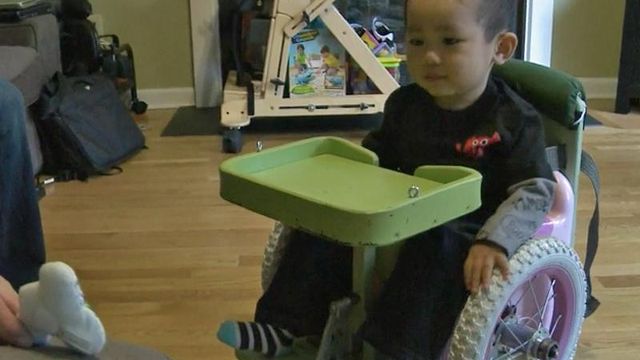Rare genetic disorder causes muscle weakness
Most children learn to crawl, to speak, stand up and walk when they're supposed to - some faster than others. When children don't hit those developmental milestones, parents want to know why. That was the case for Cary parents whose 2-year-old son was diagnosed with a rare genetic disease.
Posted — UpdatedThe attention comes not only from his parents, Mimi and Kevin Chan, but from the therapists who come for regular visits with creative ways to get him moving.
Brady has spinal muscular atrophy, or SMA – the No. 1 genetic killer of children under age 2. It destroys the nerve cells that control voluntary muscle movements.
SMA is considered rare, which makes getting a timely diagnosis difficult. The Chans noticed unusual weakness at 6 months of age, and Brady wasn't hitting his 7 or 8 month milestones.
“He didn't crawl and he was starting to really have trouble just lifting his head during tummy time,” Mimi Chan said.
Unable to find a satisfactory diagnosis at home, the Chans took Brady to China, where doctors performed a DNA test. It was positive for type 2 SMA.
Children with type 2 live longer than those with type 1, which typically leads to death before age 2.
“That lifespan is well into his 20s or his, hopefully, 30s,” Mimi Chan said. “As far as his ability to be mobile, he most likely won't be able to be mobile on his own.”
Brady's grandfather made his wheelchair, but as he grows, he'll need a powered chair.
The Chans want to raise awareness for SMA, so parents and doctors can work together for an earlier diagnosis.
“Once we knew what it was, it helped us develop a plan for how to help him,” Kevin Chan said.
“They have said that they're very close to a major breakthrough, which is really positive and makes us hopeful,” Mimi Chan said.
Duke pediatric neurologist Dr. Edward Smith says the most promising research for S MA is in the area of gene therapy to correction the mutation in the gene.
“Preliminarily, this has shown very encouraging results in the SMA mouse model,” Smith said.
Another therapeutic approach for researchers is trying to increase the activity of a back-up copy of the SMA gene that all SMA patients have.
“This gene is partially functional and produces a small amount of the SMA protein, which is necessary to keep the motor neurons alive,” Smith said. “The hope is that by increasing the activity of this back-up gene with certain compounds, enough SMA protein will be made to keep the neurons healthy and patients strong.”
• Credits
Copyright 2024 by Capitol Broadcasting Company. All rights reserved. This material may not be published, broadcast, rewritten or redistributed.





